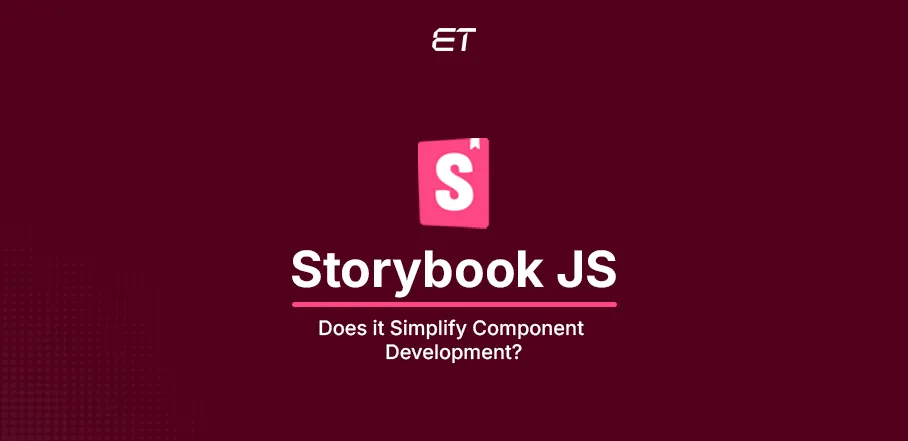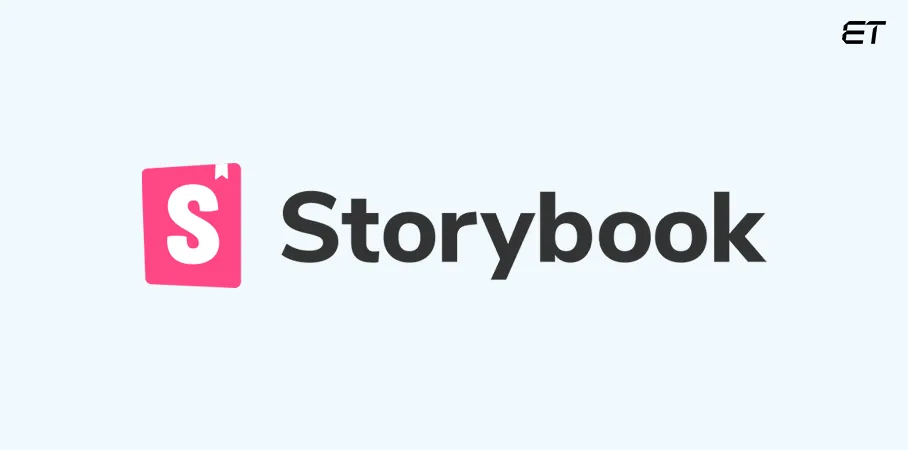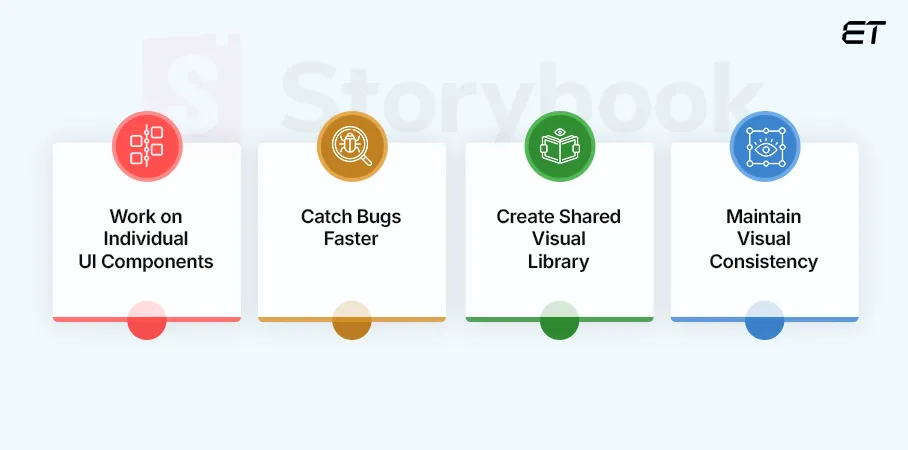
StorybookJS: The Modern UI Toolkit
StorybookJS is a powerful, open-source tool that isolates your UI components. It makes building, testing, and documenting the technical aspects easy. You should understand this tool because it can potentially enhance front-end development.
Unlike traditional methods that involve navigating complex application states, StorybookJS offers a focused, visual environment. Other tools might offer component libraries, but this option provides a dedicated space for granular control and interactive exploration.
So, if you’re ready to embrace a streamlined, collaborative workflow, discover how StorybookJS can transform your projects. Let’s dive into why this tool is quickly becoming indispensable for modern web developers.
Are you in search of efficient front-end development services? Send your details and let’s get started.
What is StorybookJS?

StorybookJS is an open-source tool for developing user interface (UI) components in isolation. It provides an environment where you can build, test, and document individual UI elements, such as buttons, forms, or navigation bars, independently from the main application.
Essentially, this tool allows you to:
- View components in various states
- Test component functionality
- Document component usage
- Organize and catalog components
The isolation aspect of StorybookJS simplifies the development process by focusing on individual components. This way, the tool makes identifying and resolving issues easier before they affect your application.
What is the Utility of StorybookJS?

StorybookJS finds its leading utility in building and maintaining user interfaces (UIs). In simple words, it makes UI development efficient and reliable.
Here are the main points to consider:
- This tool allows you to work on individual UI components without needing to run the entire application.
- StorybookJS also enables you to test components in various states (e.g., loading, error, success) to ensure they work correctly.
- It helps catch bugs early in the development process, preventing them from affecting the final product.
- StorybookJS creates a shared visual library of UI components.
- It automatically generates documentation for your components, making it easier for new team members to understand and use them.
- Having a central place to view and test UI components helps maintain visual consistency across the application.
All in all, StorybookJS helps you build higher-quality UIs faster, with better collaboration and clear documentation.
Interested in knowing about another emerging front-end platform? Read all about ViteJS in our detailed blog.
The Key Benefits of StorybookJS
Refer to the table below to understand why choosing this front-end tool can be helpful for your business.
| Benefit | Explanation |
| Isolated Component Development | You can build and test UI elements independently |
| Visual Testing and Debugging | It is easy to see and interact with components in various states |
| Enhanced Team Collaboration | You can share a visual library of components |
| Automated Component Documentation | StorybookJS generates clear documentation automatically |
| Faster Development Cycles | This tool focuses on individual components for quick iteration and prototyping |
| Consistent User Interface | It ensures visual and functional uniformity across the application |
StorybookJS: How to Get Started?
If streamlined UI is on your mind, here are the main steps that can get you up and running with this excellent tool.
1. Project Setup
StorybookJS supports popular frameworks like React, Vue, Angular, and more. Ensure you have a project using one of these frameworks. Open your terminal and navigate to your project’s root directory.
Then, run the following command to automatically set up Storybook:
Bash
npx storybook@latest init
This command will detect your project’s framework and install the necessary dependencies.
2. Explore the Default Story
After installation, StorybookJS will generate a set of example components and stories.
Run Storybook with:
Bash
npm run storybook
or
Bash
yarn storybook
This command will open Storybook in your web browser. Take some time to explore the default stories and understand the structure.
3. Create Your First Story
Inside your project’s src (or similar) directory, create a new file with the .stories.js or .stories.jsx extension (depending on your framework). For example, if you have a Button.jsx component, create a Button.stories.jsx file.
Here’s a basic example of a React story:
JavaScript
// Button.stories.jsx
import React from ‘react’;
import Button from ‘./Button’;
export default {
title: ‘Components/Button’,
component: Button,
};
const Template = (args) => <Button {…args} />;
export const Primary = Template.bind({});
Primary.args = {
primary: true,
label: ‘Primary Button’,
};
export const Secondary = Template.bind({});
Secondary.args = {
label: ‘Secondary Button’,
};
If you have any questions, get the help of skilled front-end developers.
Too technical? Contact our front-end developers to get customized code guidance.
4. Customize and Expand
Create stories for different variations and states of your components. StorybookJS has a rich ecosystem of add-ons. Explore addons for testing, accessibility, and more.
Use Markdown and code comments to document your components within your stories.
Remember, the official StorybookJS documentation is your best resource. Begin with simple components and gradually expand your Storybook setup.
System Requirements for StorybookJS

The table below can help simplify the details of essential tech requirements.
| Requirement | Details |
| Node.js | LTS version (e.g., Node.js 18+) |
| npm/Yarn | Included with Node.js, or install Yarn separately |
| Web Browser | Modern browser (Chrome, Firefox, Safari, Edge) |
| Code Editor | Any JavaScript-compatible editor (VS Code, Sublime Text, etc.) |
| Operating System | Windows, macOS, Linux |
| Project Dependencies | Dependencies for your chosen framework (React, Vue, Angular) |
When Do You Need StorybookJS?

There are certain scenarios when using StorybookJS makes more sense. Here are the main application areas of this tool.
1. Building Reusable UI Components
If your project requires reusable UI components (buttons, forms, cards, etc.), StorybookJS is invaluable. It provides a centralized place to develop, test, and document them fluently.
2. Large or Complex UI Projects
For projects with complex UIs, StorybookJS helps manage complexity by breaking the UI into smaller, manageable pieces. This aspect simplifies development and testing.
3. Collaborative Development Environments
If you work in a team with multiple developers, designers, and product managers, this tool facilitates collaboration by providing a shared visual language. It ensures everyone is on the same page regarding UI components.
4. Maintaining a Design System
StorybookJS can serve as a living style guide if your organization uses a design system. It allows you to showcase and document your design system’s components.
5. Performing Visual Regression Testing
Let’s consider you need to ensure that UI changes don’t introduce visual regressions. In this case, StorybookJS, combined with visual testing tools, can help. It allows you to compare component snapshots and detect unexpected changes.
6. Improving Component Testing
If you want to improve your component testing process, StorybookJS allows you to test components in isolation and in various states. This tool helps catch bugs early in the development cycle.
7. When Iterating on UI Design
StorybookJS is helpful when iterating on UI design. It allows for rapid prototyping, and testing of different UI states.
In a Nutshell
StorybookJS is a splendid tool for modern front-end development. It streamlines the development process by providing an isolated environment for building, testing, and documenting UI components.
Whether managing complex UIs, maintaining a design system, or aiming for higher-quality, consistent user experiences, StorybookJS can be a robust solution. Overall, this tool is worth mastering if you’re ready to elevate your front-end projects.
The right team can assist you with the appropriate tools for your business. Connect with us and reach great heights!





